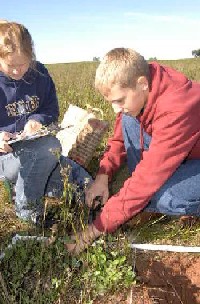EPA Plants Seeds of Change in the Torch Lake Community

Local high school students survey plant communities on the Torch Lake Superfund site in Michigan. Photo by Brenda Jones, Region 5 Remedial Project Manager
Can local area high schools become a part of EPA's monitoring and surveying project on the Torch Lake, Michigan Superfund site? Indeed they can, and they have been doing just that since 2003. In conjunction with the Western Upper Peninsula Center for Science, Mathematics and Environmental Education, EPA's regional office in Chicago has created a model monitoring program that engages the students in the Torch Lake community while furnishing EPA with the necessary data to track improvements to the soil fertility and the return of plants, birds, and mammals to the site since the remediation.
Through this collaborative effort, the high school students are learning the skills necessary to perform an ecological evaluation while providing valuable monitoring data to EPA that will help the Agency monitor the progress of the cleanup efforts. In addition, the students are planning to share their survey findings with the local community which will help them develop public speaking skills and educate the broader community about the cleanup progress at the site.
The Torch Lake Superfund site is located in Houghton County, Michigan on the Keweenaw Peninsula, a region known for its intensive copper industry during the nineteenth and twentieth centuries. In fact, the Keweenaw mines once produced over 80% of the nation's copper, but these invasive mining, milling, and smelting activities left their mark on the rich natural heritage of the community. Lake sediment and shorelines were contaminated with mill tailings (called stamp sands) since the most common disposal method of the time was to dump these wastes into Torch Lake and the other lakes in the region. Torch Lake alone received approximately 200 million tons of copper tailings, filling in 20% of the lake's volume.
The Torch Lake site was recommended for inclusion on the National Priorities List in 1984 and was added to the list two years later. The remedy for the site included covering much of the stamp sand piles with soil, replanting vegetation, and long-term monitoring of Torch Lake. Completion of cleanup activities at the site is expected to occur in 2005.
In 2002, initial habitat studies of the area revealed that an abundance of animal and plant life was again calling the Torch Lake Superfund site home. EPA wanted to continue monitoring the animal and plant life as well as the soil fertility, so in 2003, the Agency initiated a project with the U.S. Fish and Wildlife Service to train area high school biology and natural science teachers to perform long-term monitoring of the soils, plants, and birds on the site. These teachers currently represent five local high schools that are each assigned to survey a different area of the site. The teachers incorporated the monitoring program into their course curriculum and trained their students to perform the soil fertility, plant community, and bird community surveys. Additionally, the teachers agreed to perform the surveys through 2006.
To learn more about this collaborative effort, contact Brenda Jones, Torch Lake site manager, at jones.brenda@epa.gov.
Superfund Help: Acronyms | Topics | Frequent Questions | Publications | Sitemap
![[logo] US EPA](https://webarchive.library.unt.edu/eot2008/20090514051929im_/http://www.epa.gov/epafiles/images/logo_epaseal.gif)